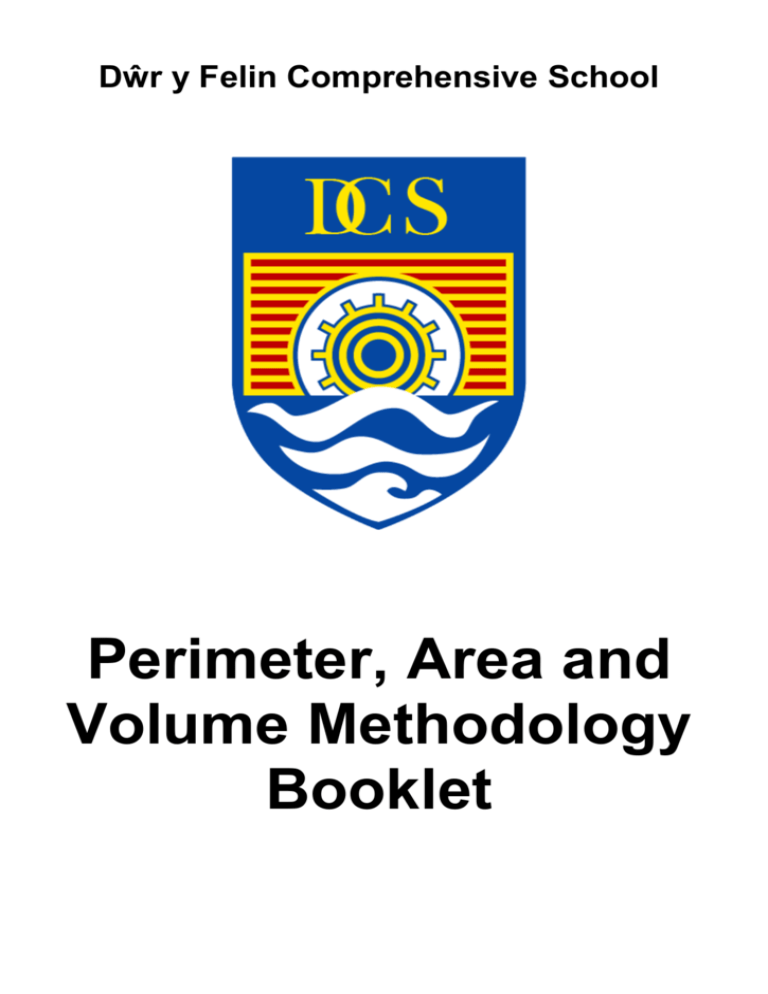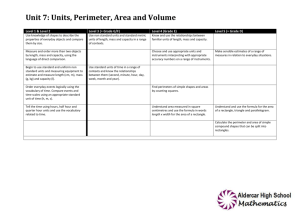Perimeter, Area and Volume Methodology Booklet
advertisement

Dŵr y Felin Comprehensive School Perimeter, Area and Volume Methodology Booklet Perimeter, Area & Volume Perimeters, Area & Volume are key concepts within the Shape & Space aspect of Mathematics. Pupils understanding of these concepts can be reinforced in subjects that require the use of spatial awareness. Throughout these topics the following skills are inherent Strand Developing Numerical reasoning Element Identify processes and connections Learners are able to • Transfer mathematical skills across the curriculum in a variety of contexts and everyday situations • Select, trial and evaluate a variety of possible approaches and break complex problems into a series of tasks • Prioritise and organise the relevant steps needed to complete the task or reach a solution • Choose an appropriate mental or written strategy and know when it is appropriate to use a calculator • Identify, measure obtain required information to complete the task • Identify what further information might be required and select what information is most appropriate • Select appropriate mathematics and techniques to use • Estimate and visualise size when measuring and use the correct units Strand Developing Numerical reasoning Element Represent and communicate Learners are able to • Explain results and procedures precisely using appropriate mathematical language • Use appropriate notation, symbols and units of measurements, including compound measures Strand Developing Numerical reasoning Element Review Learners are able to • Select and apply appropriate checking strategies • Interpret answers within the context of the problem and consider whether answers, including calculator, analogue and digital displays, are sensible Perimeter Key Teaching Point Perimeter is the distance around the outside of a shape. Pupils need to ‘add up’ all the measurements. Strand Using Measuring Skills Element Length, weight/mass, capacity Learners are able to • Find perimeters of shapes with straight sides (7MS1) Key Features • • • • Set out calculations in a structured way Pupils should be encouraged to check their work thoroughly. Answers must include units - mm, cm or metres. Pupils need to ensure all measurements used are in the same units. Common Misconceptions • Errors in basic mental addition • Missing out some of the measurements • Ignoring any lengths that are not given instead of calculating their measurements first before finding the perimeter. Examples 1. Find the perimeter of this square Perimeter = 3 + 3 + 3 + 3 =12cm When shapes are drawn on cm squared paper pupils can count around the outside or be encouraged to identify each length and then add up. 2. Calculate the perimeter of this rectangle 9cm Perimeter = 3 + 9 + 3 + 9 = 24cm 3cm The opposite sides of a rectangle are equal in length. 3. Calculate the perimeter of this regular hexagon 2cm Perimeter = 2 + 2 + 2 + 2 + 2 + 2 = 12cm OR Perimeter = 2 x 6 = 12cm Area If a shape is regular then all the sides are the same length Key Teaching Point The area of a shape is the space inside. The topic would initially be introduced with shapes drawn on cm squared paper and pupils will just need to count the squares inside a shape. This will then lead on to the following formulae being used. length Area of a rectangle = length x width width Area of a triangle = ½ x base x height height (where the height is perpendicular with the base i.e. meets at a right angle) base Strand Using Measuring Skills Element Area and volume Learners are able to • Use formulae for the area of rectangles and triangles (7MS7) • Calculate areas of compound shapes (e.g. consisting of rectangles and triangles) and volumes of solids (e.g. cubes and cuboids) (8MS6) Key Features • Answers must include units – mm2, cm2 or m2. • Pupils need to ensure all measurements used are in the same units. Common Misconceptions • Errors in basic mental multiplication • Using the wrong values, in particular not using the perpendicular height when finding the area of a triangle. • Multiplying all the values shown. Examples 1. Calculate the area of the following shapes 9cm Area = 9 x 3 = 27cm2 3cm Pupils will need to identify the length and perpendicular height 2. 6cm 6cm 4cm 8cm Area of Compound Shapes & Volume Area = ½ x 8 x 4 = ½ x 32 = 16cm2 Key Teaching Point To calculate the area of a compound shape pupils will need to split into rectangles or triangles, find the separate areas and add up to find the total area. The volume is the amount of 3-dimensional space an object occupies. The formula for the volume of a cube or cuboid is given below. Volume = length x width x height height width length Strand Using Measuring Skills Element Area and volume Learners are able to • Calculate areas of compound shapes (e.g. consisting of rectangles and triangles) and volumes of solids (e.g. cubes and cuboids) (8MS6) Key Features • Area is measured in mm2, cm2 or m2. • Volume is measured in mm3, cm3 or m3. • Pupils need to ensure all measurements used are in the same units. Common Misconceptions • Errors in basic mental multiplication • When finding the area of compound shapes pupils could easily use the wrong measurements. Examples 1. Calculate the area of the following shape. Split the overall shape into two separate shapes. Shape A is a rectangle and B is a triangle. 6cm 4cm A 7cm Area of A = 6 x 4 = 24cm2 Area of B = ½ x 6 x 3 = ½ x 18 = 9cm2 Total Area = 24 + 9 = 33cm2 B Shape B is a triangle with a base of 6cm and a height of 3cm (because 7 – 4 = 3) 2. Calculate the volume of this cuboid. Volume = length x width x height = 7x4x5 = 140cm3 5cm 4cm 7cm Circles Key Teaching Point The area of a circle is found by using the following formulae. Area of a circle = 𝜋𝑟 2 r OR Area of a circle = 𝜋 x r x r (where r is the radius of a circle, the distance from the centre to the outside and 𝜋 is the value 3.14) Strand Using Measuring Skills Element Area and volume Learners are able to • Find areas of circles (9MS4) Key Features • Area is measured in mm2, cm2 or m2. • Squaring is the same as multiplying by itself e.g. 32 = 3 x 3 = 9 • Pupils can use 3.14 for 𝜋 or use the 𝜋 button on their scientific calculator. Common Misconceptions • Errors in basic mental multiplication • Using the diameter instead of the radius. When the diameter is given – half it to find the radius Examples Find the areas of the following circles 1. 2. 4cm Area = 𝜋𝑟 2 = 𝜋(42) = 3.14 x 4 x 4 = 50.24cm2 6cm Diameter = 6cm therefore Radius = 3cm Area = 𝜋𝑟 2 = 𝜋(32) = 3.14 x 3 x 3 = 28.26cm2






![afl_mat[1]](http://s2.studylib.net/store/data/005387843_1-8371eaaba182de7da429cb4369cd28fc-300x300.png)
